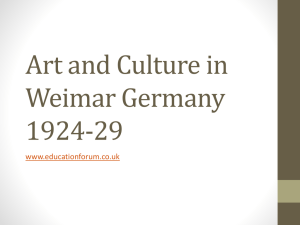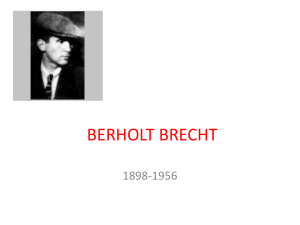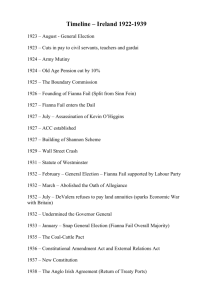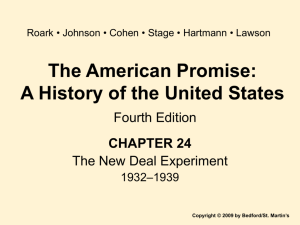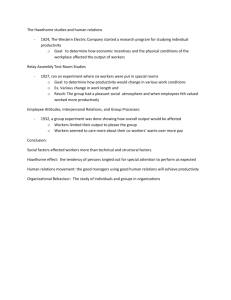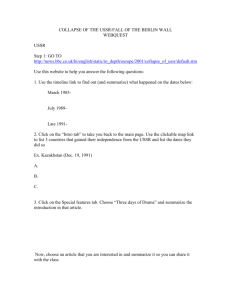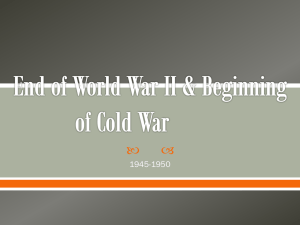Left-Wing Intellectuals in the Weimar Republic
advertisement
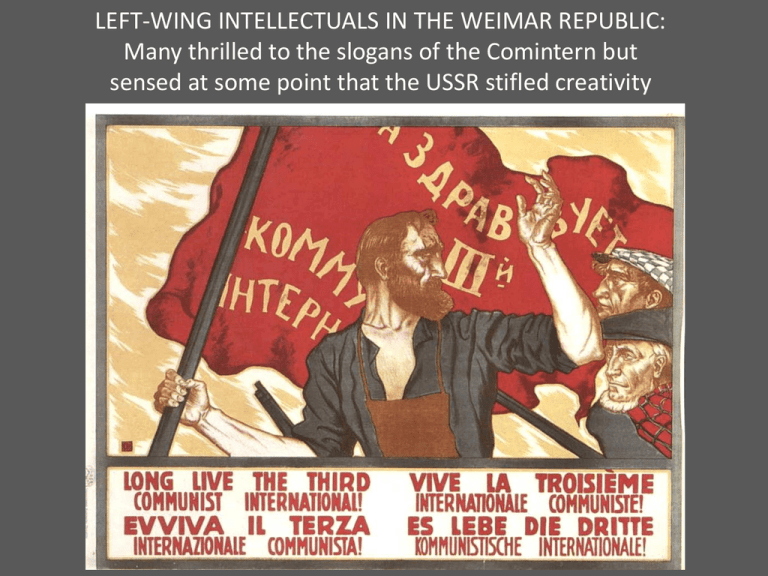
LEFT-WING INTELLECTUALS IN THE WEIMAR REPUBLIC: Many thrilled to the slogans of the Comintern but sensed at some point that the USSR stifled creativity Joseph Vissarionovich Jugashvili, code-named “Stalin” (1878-1953), photographed with Lenin in 1922 Leon Trotsky (1879-1940): Ukrainian Jew, cosmopolitan intellectual, founder of the Red Army Stalin exiled Trotsky in 1927 and then rewrote history (retouched photo of Lenin addressing Red Army recruits in Red Square in May 1920) “We will smite the kulak who agitates for reducing the cultivated area” (USSR, 1930): In 1929 Stalin launched a Five-Year Plan to collectivize agriculture and accelerate industrialization “Religion is poison. Safeguard the children” (USSR, 1930): Stalin suppressed the Uniate Catholic Church of Ukraine “Imperialists cannot stop the triumphal march of the FiveYear Plan” (USSR, 1930) “RAISE HIGHER THE BANNER OF LENINISM, THE BANNER OF THE INTERNATIONAL PROLETARIAN REVOLUTION” (N. Kochergin, 1932) THE COMINTERN RECRUITED MANY ARTISTS AND WRITERS TO SUPPORT A “HELP RUSSIA” ANTI-FAMINE CAMPAIGN IN 1921/22 (poster by Käthe Kollwitz) But George Grosz became disillusioned when he met Soviet leaders on a tour in 1922: “Many acted like living, red-bound brochures and were proud of it. Naturally they sought, since it was supposed to be the time of the masses, to suppress entirely their little individuality, and would have preferred to have faces of gray cardboard with red numbers on them instead of names.” George Grosz, Manhattan (1934): He settled in New York in 1932 and came to love America Walter Benjamin (1892-1940) was the son of a Berlin Jewish businessman who became a Marxist philosopher and literary critic. He travelled to Moscow in 1927 to pursue a career but learned that the avant-garde was being shut down…. Kazimir Malevich (1870-1935), “Suprematist Composition” 1916: He received academic promotion under Lenin and Trotsky Kazimir Malevich "The Mower" (1930): An unsuccessful attempt to adapt to Stalinist standards Bruno Voigt (1912-1988), “Anti-War Demonstration” (1932): Art in the style of “Socialist Realism” imposed by Stalin as Comintern policy in 1932 Bruno Voigt, “Attack” (1932): The crowd demands “Jobs and Bread” Bruno Voigt, “Street Fight” (1932) Bruno Voigt, “Capitalism Has Reached Its Zenith!” (1932) John Heartfield, “Fathers and Sons,” 1924 (born Helmut Herzfelde in Berlin, 1891; name change in 1916) John Heartfield, “War and Corpses/ The Last Hope of the Rich” (1932): According to the Comintern, big business could see no way out of the Great Depression except an arms race…. Heartfield, “His Majesty Adolf: I will lead you to glorious slimes!” (1932) [by changing a Z to PL, the Kaiser’s promise of “glorious times” becomes a promise of bankruptcy]. John Heartfield, “The True Meaning of the Hitler Greeting. ‘Millions Stand Behind Me!’ A Small Man Asks for Large Gifts” (1932). Heartfield toured the USSR in 1931/32 but fled to Czechoslovakia in 1933 and England in 1938 Rudolf Schlichter, “Portrait of Bert Brecht” (1926) 1898: Born into a bourgeois Augsburg family; his Protestant mother taught him the Bible 1917/18: Evaded war service by enrolling for medical study 1920: Drums in the Night, set in Berlin in January 1919 1922: In the Jungle of the Cities (inspired by Upton Sinclair) 1926: Man Equals Man (inspired by Kipling) 1927: Brecht collaborates with Erwin Piscator, Kurt Weill, and the dissident Communist theorist Karl Korsch Act II of DRUMS IN THE NIGHT (Berlin premier, 1922): The denizens of a bar are wrapped up in their private miseries as the Communists attempt their uprising in January 1919 In the Jungle of the Cities (Chicago production from 2010): “You are in Chicago in 1912. You are about to witness an inexplicable wrestling match between two men and observe the downfall of a family that has moved from the prairies to the jungle of the big city. Don’t worry your heads about the motives for the fight, concentrate on the stakes. Judge impartially the technique of the contenders, and keep your eyes fixed on the finish.” Erwin Piscator (1893-1966) was an educated bourgeois, pacifist combat veteran, and KPD member. His “New Playhouse” in Berlin deployed slideshows, film, elevators, etc. Brecht, Grosz, and Heartfield all worked here in 1927/28 to help create a “political theater” Deluge integrated film clips of insurrectionary crowds into the live action (dir. Piscator, premier on February 20, 1926) Piscator designed a tiered stage to mirror the class divisions of German society Rasputin, the Romanovs, the War, and the People that Arose Against Them, directed by Piscator, co-written by Brecht; premier on November 10, 1927. Brecht found such overt political didacticism tiresome, but he began to study the writings of Marx and Lenin with Karl Korsch. “The Piscator Stage,” caricature in Simplicissimus, January 1928. “Piscator, the priest of the new deus ex machina, whips the revolutionary spirit forward with the cry, ‘Make money!’” BRECHT, photographed in 1927 Design by Caspar Neher for the last scene of THREEPENNY OPERA Stars of the original stage production of The Threepenny Opera, Berlin, 1928: Harald Paulsen as Macheath, Roma Bahn as Polly, and Erich Ponto as Peachum, the Beggar King Will Mackie Messer hang??? (Tiger Brown at right): The KPD reviewer declared that this play contained “not a vestige of modern social or political satire.” Brecht sought to educate Marxist-Leninist revolutionaries with The Measures Taken (Dec. 1930), but it too failed to please the KPD BRECHT’S SAINT JOAN OF THE STOCKYARDS (1931) Only with The Mother (January 1932) did Brecht win applause from the Comintern In 1933 Brecht fled to Denmark, and to the USA in 1941. 1947: Subpoenaed by the House Unamerican Activities Committee 1949: Return to Communist East Berlin, which built him a theater and promised him freedom. Brecht and Helene Weigel in the May Day parade, East Berlin, 1954
